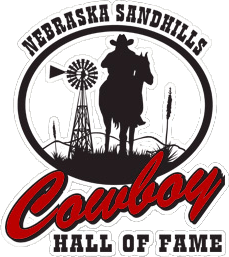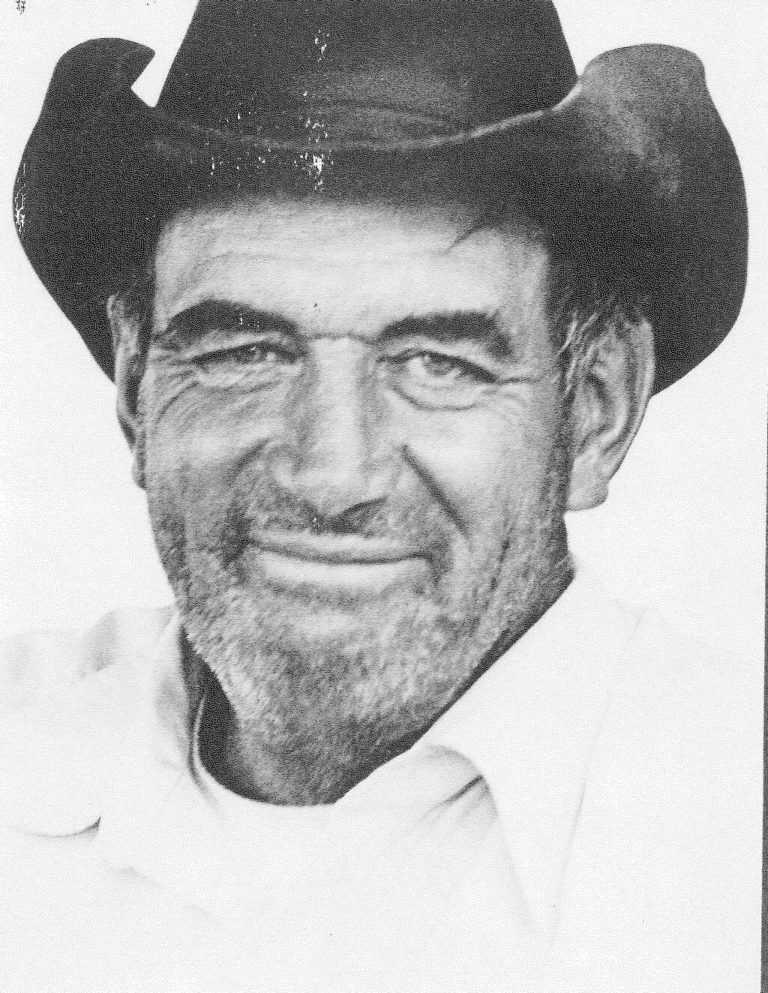April 25, 1929 – April 17, 2007
“Where did you learn so much about horses?” Someone once asked Bob Jordan. His modest answer was, “from the horses.”
Robert D. Jordan, the eldest child of Allen and Mary Jordan, was born in Crawford, Nebraska on April 25, 1929. He was joined later by his two sisters, Shirley (Phipps) and Rita (DeHaven). Like his parents most of his life was spent on the ranch (the old Gayhart place) in northern sioux County. His mom talked him into finishing high school by telling him he could ride colts three miles into Harrison from the lacey place (which Allen and Mary purchased in 1945). For the next two years Mary and the kids moved closer to town in the fall and went home when school was out in the spring. Bob and Shirley graduated from Sioux County High School in 1947 and Rita graduated in 1949.
There was some disagreement in the family over Bob’s rodeoing ways. Like some of his buddies, Bob lied to spend Sundays after church at the Hoover Stock Contracting Company Ranch west of Harrison near the Wyoming line, testing his skills. If he wanted to go to a rodeo and there wasn’t a ride available, he would simply saddle his horse and ride there. He enjoyed the camaraderie and the buckles he won. He won the All-Around title at the Crawford PRCA rodeo in the early 60’s. When Bob was granted a life membership to the PRCA his Gold Card number was 601. When he stopped competing in the rough stock events himself he continued to spend his time in the arena as a judge and served as a rough stock judge at several National High School Rodeos.
Bob met “Deene” (Eldeene Kathleen Preble) at a dance at the Buckaroo Bar in Van Tassell, Wyoming during the summer of 1950. They were married the following summer at the Catholic Church in Crawford, Nebraska. They moved into a renovated bunkhouse on the ranch and began a family. They had six children, Dan, Mary Jayne, Steve, Jim, Pat and Carol. Bob continued to work on the ranch and to rodeo. He suffered his most severe injury in 1963 when he broke his neck bulldogging a steer in Crawford. Doctors in Denver fused his neck and stuck him in a body cast. With four small children and another on the way, his mother suggested he make a deal with his dad, Bob would give up the rough stock if Allen would give up the drinking. This deal added years to both of their lives.
Bob knew that if he wanted to remain competitive he would have to do it horseback, and he wouldn’t be able to do that by riding the tough horses he picked up because no one else could ride them so he bought a registered Quarter Horse broodmare, Miss Pollyanna, and started to work building a Quarter Horse business. That’s not to say that the crowd still didn’t go wild when “old Chris” would blow up after Bob successfully picked up a rider from a bucking horse and Chris would put on a show of his own.
Bob’s first success in the Quarter Horse show ring came early when the colt Miss Pollyanna was carrying when he bought her won the 1962 CHAN Silver Cup in the halter class for yearling horse colts. Howard Pitzer made Bob an offer on the colt, Pocodo Jordan, that he couldn’t refuse. Bob had bred Miss Pollyanna back the same way, and Jordan Polly Do was the colt at her side, when Mill Pollyanna died on the Pitzer Ranch. Howard and his men did a good job of taking care of the orphan, until Bob could get there to pick her up. At that time Howard said, “Bring that filly back when she is of breeding age and I will honor the stallion fee for Two Eyed Jack that you paid for with Miss Pollyanna with her daughter.”
Jordan Polly Do replaced her mother as the foundation mare as she was the dam of three of Bob’s stallions: Strings Do, Sandy Jack Jordan, Real Pacific. Bob was always looking for a good outcross as his horse herd grew. Showing geldings wasn’t something that Bob believed in because that didn’t promote his program as well as showing mares did. He wanted his mares to have show records too, so he perfected his technique of drafting colts from his show mares onto foster moms. Tiny Bay Hancock made all five of her trips to the AQHA World Show packing a colt as she earned her Superior in the calf roping. It was at the World Show where Bob first saw Frosty Feature and knew he found the outcross horse he had been looking for.
Meanwhile, back at the ranch, Mary and Bob began the transition from Hereford to Angus cattle after Allen’s death in 1974. That is what the cattle market was dictating and there were lots of perks that came with a black herd: fewer prolapses, pink-eyed cows, sunburned bags, dehorning wasn’t needed and cattle that moved faster. Bob made sure his kids and colts got to spend lots of time working cattle. He coached and mentored lots of young men in the arena. Deene was a fabulous cook who kept them all fed. Bob worked hard and he expected his kids to work hard too. He would get the kids up early in the morning to ride horses until it was time to go to the hayfield and then they would get back on their horses after supper until it was too dark to see. The ranch arena didn’t have lights and the kids were grateful for that. His youngest daughter, Carol, is the one who followed him into the horse show ring and she helped him put points on some of the horses. His oldest son, Dan, followed him into the rodeo arena and qualified for the National High School Rodeo Finals in bareback riding.
Because of the remote location of the ranch, Ma Bell wasn’t interested in providing telephone service, so the Jordan’s and their neighbors started their own phone cooperative that stemmed out of Ardmore, SD. Perhaps the neighbors learned to regret that decision because it was a party line where different rings indicated who the calls were intended for. Bob talked the telephone operator into being his 2 a.m. alarm clock when it was time to check cows in the spring so everyone on the line got the same wake-up call. One of his gag awards while he served on the Board of Directors for the Center of the Nation Horse Association was a tiny pink doll’s telephone because he didn’t think anything of calling someone at 3 a.m. to talk horses.
Over the years, Bob worked with various partners to put on an annual horse sale. The first four sales were held at the Chadron Sale Barn with Henry and Helen Bray, then he partnered with Charlie Christiansen and the horse sales moved to Lusk, Wyoming. Then the horse sales moved to Fort Robinson where it was first held in a circus tent and then it moved into a barn and then the mare barn complex in later years. There were several reasons for moving the sale to Rapid City at the Central States Fairgrounds. One of which it was closer to a regional airport so that folks had an easier time flying in for the sale and another of which it was closer for his partner, Lewis McGill from Broadus, Montana. The final dispersal sale was held at Platte Valley Livestock in Gering, Nebraska, following Bob’s death in 2007. There was one thing that remained consistent, regardless where the sale was held–if someone needed to return a horse, Bob would always buy it back at the purchase price. Bob’s horses scattered from coast to coast and border to border. Paul Tierney was putting on a roping clinic in Madison Square Garden when he noticed a big gray horse standing in the corner of the pen. It was of course one that came from the Jordan program. Bob’s vision was to put quality horses in the hands of other PRCA members and he realized that dream more than once.
Bob wasn’t just a good horseman; he was a good cowman as well. He didn’t brag on himself but he was proud of his kids and his horses. He would tell all the nurses who helped him with his dialysis the last year of his life all about both. Bob hated being tied up to a post (that was his term) and he missed being able to ride. Bob was preceded in death by his wife in 1993 and his mother in 1995. He died on April 17, 2007 at Rapid City Regional Hospital eight days short of his 78th birthday.
Some of Bob’s achievements have been All-Around Cowboy at the Crawford PRCA rodeo in the early 1960’s, having multiple winners in regional AQHA shows to earn points to qualify horses for the AQHA World Show, having point earners in reining, cutting, working cow horse, halter, calf roping and team roping (both heading and heeling), qualifying multiple horses for the AQHA World Show in the late 70’s and early 80’s. He was honored after his death in 2007 with the honor of the Ride the Ridge Trail Boss, his children rode in his place with one of them riding Bob’s personal saddle horse — the only horse kept from his massive herd after his death.

